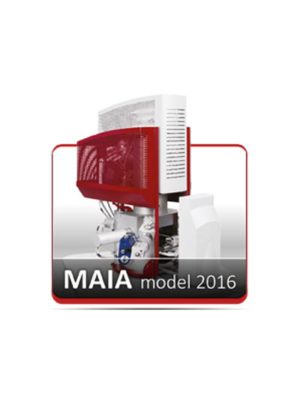MAIA3 2016

MAIA3 2016
The MAIA3 model 2016 is an ultra-high resolution SEM with excellent imaging capabilities in the whole range of beam energies. A versatile detection system and high spatial resolution allows the observation of even the finest surface details. This is an essential feature for comprehensive characterisation of nanomaterials, for observation of beam-sensitive samples common in the semiconductor industry and for comfortable imaging of non-conductive samples including uncoated biological specimens.
Key Features
TriglavTM – newly designed UHR electron column equipped with the TriLensTMobjective along with an advanced detection system
- Extraordinary resolution with the UH-resolution lens (60° immersion lens). Completely new high-resolution Analytical lens for field-free analytical work. A re-designed Intermediate lens for an extra-large field of view
- Unique combination of crossover-free mode and UH-resolution lens for outstanding imaging performance
- Traditional TESCAN Wide Field Optics™ design offering a variety of working and display modes
- EquiPower™ for excellent column stability
- New Schottky FE gun now enables beam currents up to 400 nA and rapid beam energy changes
- Up to 12” wafer SEM inspection by means of extended chambers and dedicated holders
- Triple BSE detection TriBE™ for angle-selective signal collection. The Mid-Angle BSE and In-Beam LE-BSE detectors are located inside the column and detect medium-angle and axial backscattered electrons, while the In-Chamber BSE Detectordetects wide-angle electrons. Together, they deliver a variety of imaging contrasts and enable low-energy detection down to 200 eV.
- Triple SE detection TriSE™ to capture SE signal optimally in all working modes. The In-Beam SE detector inside the column enables detection of electrons at very short working distances. SE detector for beam deceleration mode gives ultimate resolution in BDM. The In-Chamber SE detector delivers superb topographic contrast.
- Beam Deceleration Technology (BDT) for excellent resolution at very low beam energies down to 50 eV (optional)
- Real-time In-Flight Beam Tracing™ for performance and beam optimization
- Extended low-vacuum mode with chamber pressures up to 500 Pa for imaging non-conducting specimens
Superb ultra-high resolution of 1 nm at 1 keV
The unique combination of immersion optics and crossover-free mode results in extraordinary ultra-high resolution imaging at low energies. The single-pole type objective lens creates a strong magnetic field around the sample and dramatically decreases optical aberrations. Avoiding any crossover in the column reduces the Boersch effect and further optimises the electron beam to yield a superior resolution of 1 nm at 1 keV.
Imaging at low and ultra-low beam energies
Beam deceleration technology (BDT) consists of the beam deceleration mode (BDM) and high-performance In-Beam detectors for simultaneous SE and BSE signal detection in this mode. In the BDM, the energy of the electrons in the beam is decreased before they impact the surface of the specimen by means of a negative bias voltage which is applied to the sample stage. Ultra-low landing energies down to 50 eV (or 0 eV in manual control) are achievable. BDM enhances the performance of the electron column by reducing optical aberrations, thus allowing small spot sizes and high-resolution imaging at low energies. Low electron energies are advantageous for reducing charging effects in non-conductive samples as well as for imaging beam-sensitive and uncoated biological specimens. In this mode, the ultimate resolution is achieved for maximum surface sensitivity and outstanding topographical and material contrast.
Applications
MAIA3 model 2016 is the ideal choice for imaging non-conductive and beam-sensitive samples including all kinds of biological samples in their natural state. MAIA3 model 2016 enables highly sensitive surface analysis making it suitable for imaging samples with high topography. It is the SEM system of choice for keeping up with the increasing demand in all fields of science and technology for high-quality imaging at low beam energies.
Materials Science
The MAIA3 model 2016 represents a significant advance in the characterisation of nanomaterials. It is also suitable for observation of beam-sensitive and non-conductive samples (e.g. ceramics, polymers, glass, fabrics, etc.).
Semiconductors, optoelectronics and photovoltaics
The MAIA3 model 2016 can be effectively used for failure analysis in the semiconductor industry (inspection of integrated circuits, observation of ultra-thin semiconductor sections, solar cells, nanosensors, etc.).
Lithography
The MAIA3 model 2016 is a powerful tool for use in the field of electron beam lithography, furthermore is especially suited for imaging sensitive resists, which are prone to high-energy beam damage.
Life Science
The MAIA3 model 2016 with ultra-high resolution at the lowest beam energy can effectively be used for observation of samples in their natural state without using conductive coatings.

